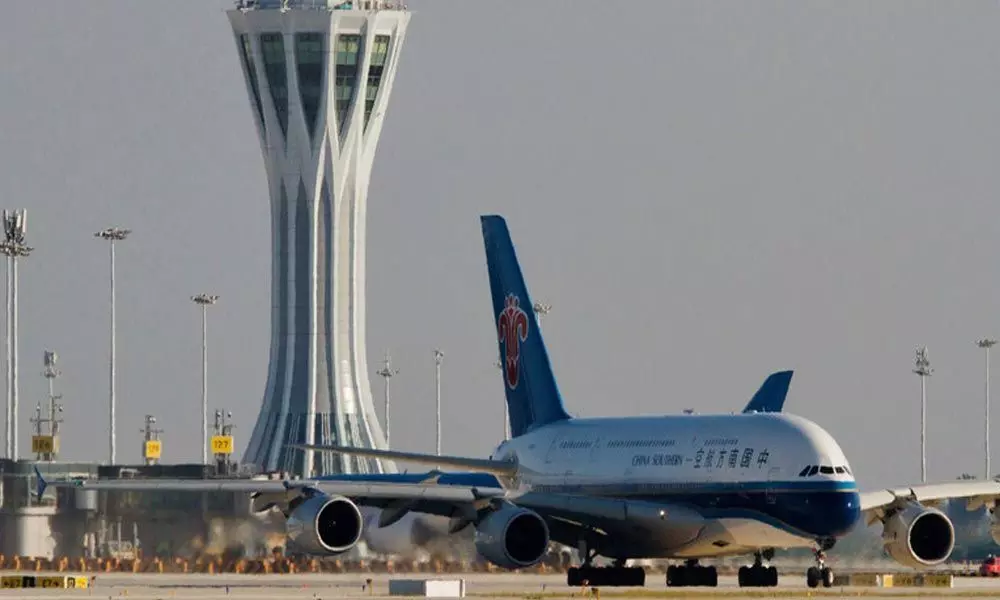Live
- Sanju Samson and Tilak Varma Shine: Record-Breaking Feats in 4th T20I Against South Africa
- India Urges $1.3 Trillion Annual Climate Support for Developing Nations
- Bad air: 106 shuttle buses, 60 extra Metro trips planned to make Delhiites give up cars
- WHO reports declining monkeypox cases in Congo
- CM Attends Kotideepotsavam on Kartika Purnima
- PKL Season 11: Raiding trio of Devank, Ayan, Sandeep help Patna Pirates rout Bengal Warriorz
- Food waste crisis fuels sustainable practices across APAC food & beverage industry: Report
- AI helps erase racist deed restrictions in California
- ATMIS completes third phase of troops' drawdown in Somalia
- PM Kisan Samman Nidhi scheme bringing smile to Nalanda farmers
Just In
Welcome to Daxing: the world's biggest airport


“And if you look out your window, you’ll see the giant starfish where we’ll soon be landing.”
"And if you look out your window, you'll see the giant starfish where we'll soon be landing."
These could now be the words of pilots making their final approach into China's newest and shiniest – and the world's biggest – airport.
Reportedly costing $63 billion, Beijing Daxing International Airport (PKX) opened on 25 September.
The opening ceremony, attended by President Xi Jinping, came just days before the country marks the 70th anniversary of the founding of the People's Republic of China with its National Day on 1 October.
Nicknamed the "starfish" and designed by the architecture team of the late Zaha Hadid, the terminal building alone covers 700,000 sq km. It's expected to become one of the world's busiest airports, initially handling up to 45 million passengers per year and 100 million after further expansion. This is intended to relieve congestion at the capital's existing airport.
Zaha Hadid Architects say the futuristic design is inspired by principles of traditional Chinese architecture, in which interconnected spaces are organized around a central courtyard. In this case, the farthest boarding gate is less than an eight-minute walk from the security checkpoint.
Eco design
The terminal was built with renewable energy in mind. Solar panels are installed throughout the airport to provide a minimum capacity of at least 10MW. Heating is provided by both a ground-source heat pump and waste heat recovery.
The architects explain the airport also collects rainwater and its water management system "employs the natural storage, natural permeation and natural purification of up to 2.8 million cubic meters of water in new wetlands, lakes and streams to prevent flooding and counter the summer 'heat island' effect on the local microclimate."
A balancing act
China is set to overtake the US as the world's largest aviation market by 2030, according to the International Air Transport Association (IATA) – fuelled by a growing, more affluent middle class.
Daxing is just one of 74 airports planned by the Civil Aviation Administration of China, to make a total of 260 by 2020.
More planes inevitably mean more greenhouse-gas emissions. Today, air transport accounts for about 2% of global man-made carbon emissions. The industry is addressing the issue with measures including improving the fuel efficiency of planes, capping net emissions from international flights at 2020 levels and a target to cut net emissions by 50% by 2050 (relative to 2005 levels).
By 2020, however, emissions from global aviation will be around 70% higher than in 2005, and the International Civil Aviation Organization (ICAO) predicts by 2050 they could grow by a further 300-700%.
Towards cleaner air
At the recent Sustainable Development Impact Summit in New York, the World Economic Forum unveiled a new partnership with the Clean Air Fund, a philanthropic initiative to tackle air pollution.
More than 90% of people breathe polluted air, and the OECD estimates the world will lose $2.6 trillion by 2060 if outdoor air pollution is not addressed.
The Forum and the Clean Air Fund will work with governments, civil society, the health sector and businesses to find solutions to air pollution.
The private sector can improve air quality by lowering emissions in supply chains, innovating clean technologies and products and encouraging employees to commute in climate- and air-friendly ways.
Source: world economic forum

© 2024 Hyderabad Media House Limited/The Hans India. All rights reserved. Powered by hocalwire.com






